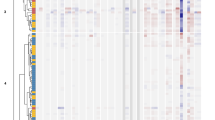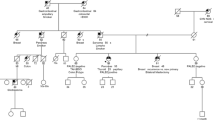Abstract
PTEN/MMAC1/TEP1, encoding a dual-specificity phosphatase, is a tumor suppressor gene which has recently been cloned and mapped to chromosome 10q23.3. We have shown that germline mutations of PTEN are present in individuals with two hamartoma syndromes: Cowden Syndrome, associated with a predisposition to breast and thyroid cancers, and Bannayan-Zonana syndrome. Somatic mutations of PTEN have been reported in a variety of human cancer cell lines, suggesting a potential role for this gene in the pathogenesis of human malignancies. We report the identification of a highly conserved PTEN processed pseudogene, ψPTEN, which shares over 98% homology with the coding region of functional PTEN, and its localisation to chromosome 9p21. The high sequence homology of ψPTEN with the PTEN transcript may potentially lead to misinterpretation when performing mutation analyses based on cDNA templates. Caution should be exerted when using such screening approaches.
Similar content being viewed by others
Author information
Authors and Affiliations
Rights and permissions
About this article
Cite this article
Dahia, P., FitzGerald, M., Zhang, X. et al. A highly conserved processed PTEN pseudogene is located on chromosome band 9p21. Oncogene 16, 2403–2406 (1998). https://doi.org/10.1038/sj.onc.1201762
Received:
Revised:
Accepted:
Published:
Issue Date:
DOI: https://doi.org/10.1038/sj.onc.1201762
- Springer Nature Limited
Keywords
This article is cited by
-
PTEN/PTENP1: ‘Regulating the regulator of RTK-dependent PI3K/Akt signalling’, new targets for cancer therapy
Molecular Cancer (2018)
-
Estrogen affects the negative feedback loop of PTENP1-miR200c to inhibit PTEN expression in the development of endometrioid endometrial carcinoma
Cell Death & Disease (2018)
-
A comprehensive genomic pan-cancer classification using The Cancer Genome Atlas gene expression data
BMC Genomics (2017)
-
Decreased expression of pseudogene PTENP1 promotes malignant behaviours and is associated with the poor survival of patients with HNSCC
Scientific Reports (2017)
-
A study on promoter methylation of PTEN in sporadic breast cancer patients from North India
Breast Cancer (2016)




